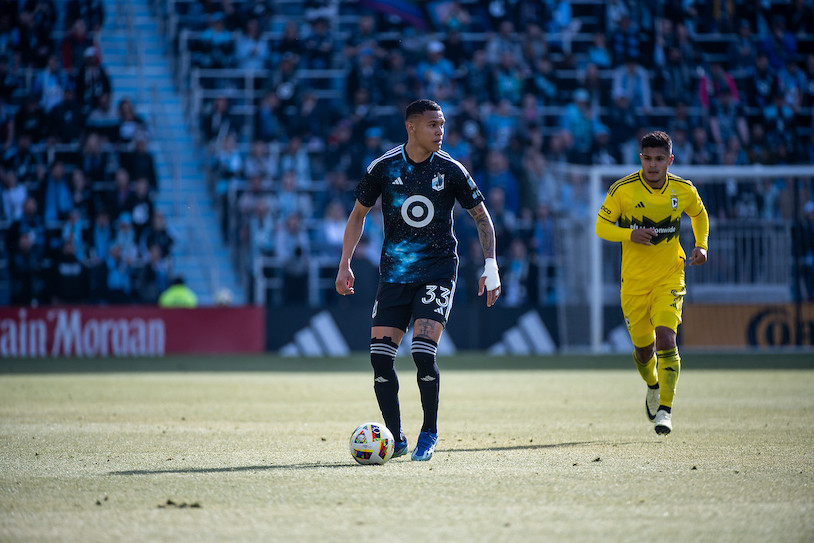Why MNUFC sold Kervin Arriaga

Kervin Arriaga has been one of the breakout players for Minnesota United this season – so much so that he’s now moving to play under even brighter lights in Europe.
The 26-year-old Honduran is joining Serbian giants FK Partizan, for a mid-six-figure transfer fee, one that could increase depending on Partizan’s success. The Belgrade club, 27 times league champions, will attempt again this year to dethrone cross-town rivals Crvena zvedza – better known here as Red Star Belgrade – for the first time since 2016-17.
Partizan is also in the UEFA Champions League second qualifying round, with their first game set for July 23rd or 24th; they would need to win three rounds of play-offs to make it into the 36-team group stage.
I tell you all this because it’s the beginning of trying to explain something that doesn’t make immediate sense: why would Minnesota United sell Kervin Arriaga?
To go back to the beginning: Minnesota signed Arriaga prior to the 2022 season, sending $100K in General Allocation Money to Austin FC (split over two years) to acquire his rights. Arriaga, who had already played five seasons in his home country before signing in Minnesota, became a low-risk, high-reward signing, starting 41 games over three seasons.
MNUFC picked up the option on Arriaga’s contract last offseason, but the Honduran was going to be out of contract at the end of 2024. He fell out of the regular starting lineup during 2023, partially due to injuries and partially due to a propensity towards earning yellow and red cards.
Through the first seven games of this season, Arriaga made zero starts. But when the Loons went to Charlotte, manager Eric Ramsay debuted an unexpected formation: a back five, with three center backs, including Arriaga on the right. It allowed the 6’3” former midfielder to use both his height, and his ball-playing ability, to the greatest effect.
While Arriaga played as a traditional center back, he was also at the center of two tactical wrinkles for Minnesota. First, he’s been the most common target for the Loons on goal kicks, using his height and leaping ability to try to win headers and leave Minnesota in place to start an attack. Second, Arriaga would occasionally push forward and overlap on the outside of the right wing, giving the Loons attacking width from an unexpected (and usually un-covered) spot.
In addition, Arriaga has been a key weapon from corner kicks, something the Loons have used to great effect. In eight starts at center back, Arriaga scored three goals, the same number as he scored in more than two years combined as a midfielder – and two of them were headers from corner kicks.
In other words, Arriaga has been one of the unsung heroes of the Minnesota United season. And the guy who replaced him in the starting lineup recently, Victor Eriksson, has struggled so much that the club is letting him go this week as well.
You can understand why fans might be aggrieved – especially fans like me, who grew up entirely with American sports, where we’ve been taught to entirely and only look at player transactions from the team’s perspective.
It’s odd to even think about it from the other perspective. You can’t imagine the Twins trading, say, Willi Castro; it’d blow a hole in the team’s depth, not to mention getting rid of the guy who’s capably filling in at second base. In order to understand this one, though, I think you probably have to consider it from Arriaga’s point of view.
I won’t try to climb into the player’s mind, in terms of why he’d want to trade the United States for Europe – though like a lot of players, he’s referred to Europe as a dream destination. Just looking at Partizan’s potential path to the Champions League group stage, there’s a certain surreal FIFA-ish quality to the opponents: Dynamo Kyiv in their first tie, then maybe Rangers or Slavia Prague in the second, maybe Lille or Fenerbahce after that.
It’s all a little more gilded than “home and away against the Vancouver Whitecaps.”
Ignoring that, though, the move just makes financial sense for Arriaga. The center back was earning $259,667 in guaranteed compensation this season, according to the salary guide released by the MLS Players Association, with even smaller salaries the previous two seasons. That’s certainly fine money, but not life-changing stuff, and careers are short; Arriaga will be multiplying his salary at Partizan, in a way that he’d likely never be able to do in MLS.
So if Arriaga wanted to go - and it was very clear that he did, and would do whatever it took to make the move happen - MNUFC’s hands were tied. They were faced with two choices: sell high, bring in some money, and cross their fingers for a few weeks until the MLS transfer window opens on July 18 – or keep him, deal with an unhappy player for the rest of the season, then lose him for nothing in the winter when his contract is over.
MNUFC chose the only sensible route. It doesn’t make things easy for them, though. The Loons have been playing with three center backs – and now are down to three players who’ve made a start in that back three this year: Michael Boxall, Miguel Tapias, and Devin Padelford.
Minnesota, though, does now have plenty of roster flexibility. The team has six open roster spots, at last count, plus two open international slots and one open spot for a designated player, with additional possible flexibility at the top end of the roster.
It’s not going to be easy for the Loons. Tall, skilled center backs don’t just fall out of the sky. But unfortunately for Minnesota, once their Honduran decided he wanted out, they didn’t have another good option.